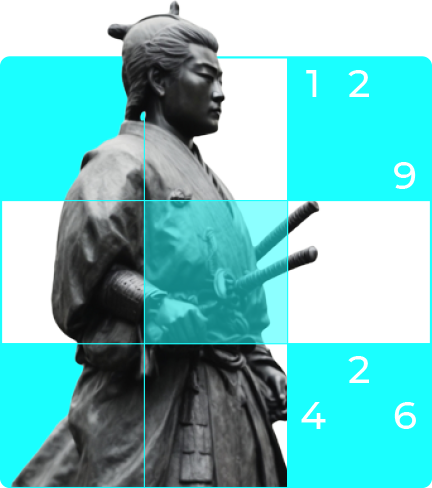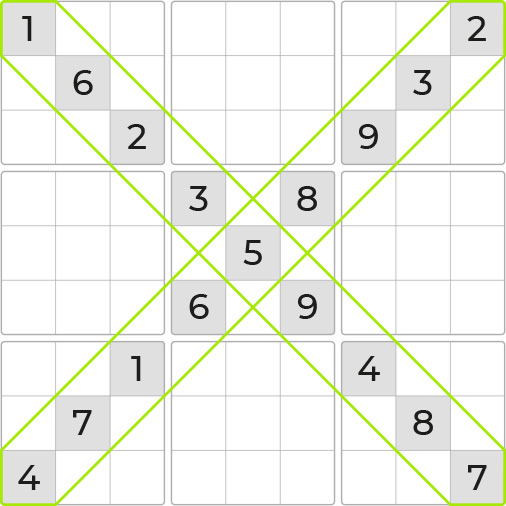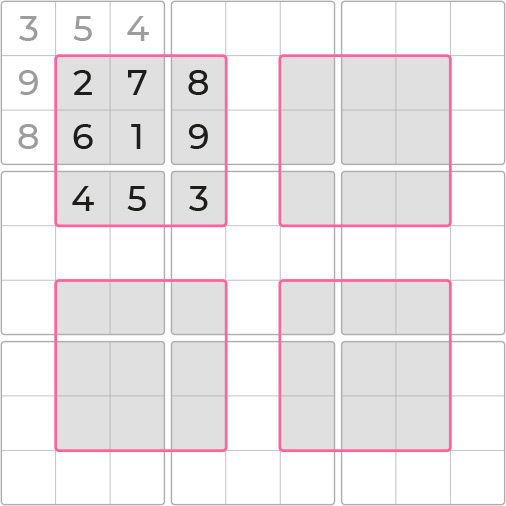how to
play sudoku

Sudoku, as we know it today, has its roots in ancient number puzzles, but the modern version of Sudoku was developed in the late 20th century. It became popular in Japan in the 1980s after it was introduced by the puzzle company Nikoli. They introduced the name “Sudoku,” which is short for “Sūji wa dokushin ni kagiru,” meaning “the numbers must be single” or “the numbers must occur only once.” In Japanese, “Su” means number, and “Doku” means single or solitary. The name “Sudoku” endured, but it only became a global phenomenon in early 2000s. The puzzle started gaining traction in the Western world.
People all over the world now play Sudoku as a form of entertainment, and also for the proven mental benefits. Among others, Sudoku helps to improve your memory and concentration, reduces the risk of Alzheimer’s, and can even contribute to reducing anxiety.
The basic rules
of Sudoku
Sudoku is a puzzle game where you fill in numbers on a 9×9 grid, divided into nine smaller 3×3 blocks. The goal is to fill the entire grid with numbers from 1 to 9, following these rules:
rows
Each number from 1 to 9 can appear only once in each row.

columns
Each number from 1 to 9 can appear only once in each column.

3×3 blocks
Each number from 1 to 9 can appear only once in each 3×3 block.

steps to play
sudoku
Scan the board: Start by scanning the board to see which numbers are already placed, what placed numbers occur most frequently, and which blocks hold most of the numbers. This gives you an idea of which numbers you might be able to fill in the empty cells.
Look for certainties: Check if there are rows, columns, or 3×3 blocks where you can confidently place a number because it’s the only possibility left.
Elimination: If you’re unsure about which number should go in a particular cell, look at the other numbers in the row, column, and 3×3 block. By elimination, you can often determine which numbers are possible candidates for a specific cell.
Make notes: If you’re unsure about which number should go in a cell, you can add small numbers, called notes, in the same cell as possible options. Later, as you gather more information, you can revisit these possible candidates.
Keep going: Continue placing numbers you’re certain about and use elimination to determine other numbers. Sometimes, you don’t see the solution immediately, however, all Sudoku games within Sudoku X have only one possible solution and can be solved through logical reasoning. No guessing needed, be patient, and keep going.
Check your work: Once you think you’re done, go through each row, column, and 3×3 block to ensure you haven’t broken any of the basic rules.
Different
Levels Explained
The difficulty level of a Sudoku puzzle is typically determined by the number of given clues, the placement of these clues, and the solving techniques and the number of steps required to complete the puzzle. Next is a summary of the differences in difficulty levels:
BEGINNER:
Our Beginner level Sudoku boards assume you are new to Sudoku. Typically these hold many clues (~45) and only require you to know two placement techniques to solve, i.e. Last Free Cell and Last Possible Number. The numbers of steps required to complete the board is small.
EASY:
Our Easy level boards are a step-up compared to the Beginner’s. You will have fewer clues (~34) amd need more steps to complete the Sudoku game. Next to the placement tecniques required at Beginner level you need to familiarize yourself with the Single Possible Position technique. Try also playing this level without making use of notes.
MEDIUM:
With our Medium level boards the first basic elimination techniques are introduced. You will need to master techniques like Naked Pairs, Pointing Pairs and Box-Line Reduction to solve the Sudoku board. The number of starting clues is further limited (~27). You might want to start using notes.
HARD:
Given Clues:
There are usually more given numbers, often around 40 or more.
Solving Techniques:
Basic techniques like scanning and single possibility are often enough to solve these puzzles.
Placement:
The given numbers are usually distributed in a way that makes it relatively straightforward to find the next number.
EXPERT:
Given Clues:
There are usually more given numbers, often around 40 or more.
Solving Techniques:
Basic techniques like scanning and single possibility are often enough to solve these puzzles.
Placement:
The given numbers are usually distributed in a way that makes it relatively straightforward to find the next number.
MASTER:
Given Clues:
There are usually more given numbers, often around 40 or more.
Solving Techniques:
Basic techniques like scanning and single possibility are often enough to solve these puzzles.
Placement:
The given numbers are usually distributed in a way that makes it relatively straightforward to find the next number.
variations
Different Sudoku
Variations
There are various variations for Sudoku X. For example, the X variant and the Windoku variant.

Sudoku X
(Diagonal Sudoku):
In addition to the rules of Classic Sudoku, each number from 1 to 9 must also appear only once in each of the two main diagonals. This means that, along with the rows, columns, and 3×3 blocks, the two diagonals (from top-left to bottom-right and from top-right to bottom-left) should also not have any repeated numbers.
This additional constraint makes Sudoku X a bit more challenging than the classic version because you have to keep the diagonals in mind while solving. The visual “X” formed by the two diagonals gives this variant its name.

Windoku:
This Sudoku puzzle uses a standard 9×9 grid, just like classic Sudoku but in addition to the standard nine 3×3 blocks, there are four extra regions located in the center of the grid. These regions are typically marked by shaded or dotted cells. Each of these extra regions also contains nine cells.
Rules:
- Each row must contain each number from 1 to 9 exactly once.
- Each column must contain each number from 1 to 9 exactly once.
- Each of the standard 3×3 blocks must contain each number from 1 to 9 exactly once.
- Each of the four extra regions in the center must also contain each number from 1 to 9 exactly once.
The added challenge in this variant comes from the extra regions, which introduce more constraints to the puzzle. This means that while solving, you have to keep in mind not only the rows, columns, and standard 3×3 blocks but also the additional central regions. This can make the puzzle more challenging compared to the classic version.
enjoy
Sudoku X
~Three in One
Play now
The difference between
analog and digital Sudoku
In the past, Sudoku was played only on paper, but nowadays, the digital game version is gaining immense popularity. Below are the advantages of Sudoku Game apps.
| Analog Sudoku | Sudoku Game App | |
| Medium | Paper (puzzle books, newspapers) | Digital device (smartphone, tablet, computer) |
| User Interface | Pen or pencil for input. Erasing can be messy | Clean digital interface with easy input, removal, and note-taking |
| Features & Tools | Basic, no additional tools | Hints, error-checking, timers, tutorials, multiple difficulty levels |
| Portability | Requires carrying paper/booklets | Available on a mobile device you might already carry |

